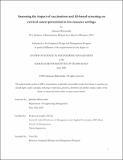| dc.description.abstract | Cervical cancer disproportionately impacts lower-middle income countries (LMICs), with over 90% of cervical cancer related deaths occurring in these nations. Despite significant research and knowledge on how to prevent and manage cervical cancer, many women in low resource settings lack access to the necessary vaccinations, screening, and treatment. The WHO strategy for cervical cancer elimination recommends that: 90% of girls are vaccinated by the age of 15; 70% of women are screened using a high-performance test by the age of 35, and again at 45; and lastly that 90% of positively screened women are treated or their cancer is managed. These targets are optimistic relative to the current levels of prevention and treatment in LMICs.
Through this paper, we use HPVsim (an agent-based simulation model created by the Institute of Disease Modeling) to simulate the impact of vaccinations, screening, and treatment on health outcomes such as HPV prevalence, cervical cancer incidence, and mortality. We focus specifically on the impact of Automated Visual Evaluation (AVE); an AI based screening technology developed by Global Health Labs that leverages machine learning models to diagnose precancer.
Our results demonstrate that in the long term, HPV vaccination is more effective than screening and treatment strategies in reducing age standardized cervical cancer incidence rates (ASIR). Vaccinations are predicted to reduce ASIR by 41%, compared to 12% for screening and treatment interventions over the next 35 years. Although the impact of vaccinations is greater than the impact of screening and treatment in the long run, the effects of vaccinations take years to be realized. Therefore, the importance of screening is critical in the short run. The paper also evaluates the impact of AI based screening interventions (such as AVE). We find that in the long term (i.e., after 35 years), a 1% increase in screening probability is associated with a reduction in ASIR of 0.019, a 1% increase in treatment probability is associated with a reduction in ASIR of 0.015, and a 1% increase in AVE device sensitivity is associated with a reduction in ASIR of 0.09.
We supplement our analysis with primary research interviews, which focused on best practices for deploying AI based cancer screening technologies. Our interview findings emphasize the importance of a systems approach and underscore the need to implement screening tools within the behavioral and social contexts of the societies being served. Overall, our study provides insights into the potential impact of cervical cancer prevention strategies and highlights the importance of tailored and context-specific approaches to screening and treatment in LMICs. | |
